LED lighting systems are showing promise for applications at airports and on aircraft, both in the military and commercial sectors. Their attributes are well-known – crisp lighting, energy efficiency, long lifetimes, low voltage requirements, compact size, fast on/off time, shock resistance and no color filter requirements. Applications for LED illumination in aviation range from wing-tip lights to indicator lights on flight decks to pilot guidance lights on airfields to mood lighting in aircraft cabins.
Work is progressing to leverage the advantages of LED lighting in the aviation industry and to overcome challenges presented by the technology, such as in the areas of thermal management and in retrofitting the technology into existing lighting systems.
On runway thresholds
From April 2004 to April 2005, researchers from Embry-Riddle Aeronautical University in Prescott, Ariz., and from the University of North Dakota in Grand Forks field-tested LED lamps at the runway thresholds of Sky Harbor International Airport in Phoenix (PHX) and of Grand Forks International Airport (GFK) – locations chosen largely to test the lighting in both hot and cold weather conditions. The Federal Aviation Administration (FAA) funded the study and provided the lamps, produced under contract with a group from John Carroll University in University Heights, Ohio.
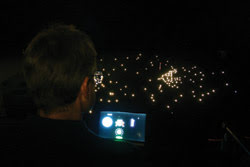
A study subject views a scale model simulation of a remote airfield and surrounding community at night. Courtesy of the Lighting Research Center at Rensselaer Polytechnic Institute.
Led by Stephen J. Kahne, professor of engineering at Embry-Riddle, the investigators measured the illumination, power consumption and other characteristics of the lamps as well as how they fared in environmental conditions such as extreme temperatures, precipitation and jet blast vibrations.
Airport trials: North and South
At the two airports, they replaced the traditional incandescent threshold lamps with LED lamps on one runway each. Kahne said that the threshold identification at commercial airports typically is 18 lamp fixtures spaced across the end of a runway, with 300-W white incandescent lamps with green filters. Green is the standard color for these markers. They used standard PAR56 bulb housing units.
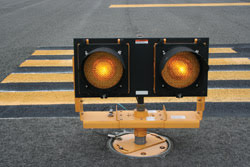
Shown is an airport runway guard light. Courtesy of the Lighting Research Center.
The suppliers designed and produced 45 LED replacement bulbs for the study. The new units comprised the LED bulb, consisting of 26 1-W green LEDs and an AC to DC converter – because LED lamps require a DC power source. The researchers conducted the tests using the existing PAR56 fixtures, without changing the power sources. FAA personnel simply removed the incandescent bulbs and inserted the new LED units.
Kahne noted that the new units used only about 10 percent of the power required by the incandescent lamps. The LED technology is energy efficient, and the LED light energy did not require that filters be used to discard most of the source energy to obtain only the green part of the light spectrum, he said.
Although the LED lamps were designed for decade-long operation, four of the 36 laboratory-built prototype lamps used at the two airports had to be replaced within the 12-month period. The cause was determined to be relatively small design faults, however, rather than environmental or operational issues. Kahne estimated that incandescent lamps typically must be replaced about once a year and noted that the airport maintenance staff was impressed by the new technology.
Commercial pilots had no negative comments about the color, intensity or other characteristics of the lamps, Kahne said. Although there were substantial light-intensity variations as part of the testing, they did not mention them, he added.
There were no negative effects resulting from environmental extremes at either airport, he said, although he would like to see further study on the possible effects of high humidity and temperature. Harsh man-made activities at the airports (jet blast, radio-frequency signals and normal maintenance activity, including dust sweeping and snow removal) also had no negative impact on perceived light output or power consumption.
In Kahne’s view, many of the barriers to the use of LED lighting are political. There is little financial incentive for the FAA to rapidly approve energy-efficient solutions to lighting problems at airports because the airport owners bear the cost, he said. Newer models are constantly being designed, he said, adding that it would be valuable to have a clearinghouse for such testing – if there isn’t one already.
LED taxiway edge and centerline lights
Taxiway LED edge lights have been available for several years and have progressed in design. Taxiway centerline lights – and several other varieties of guidance lighting on the airfield – also have recently become available, according to David N. Rainey, vice president of airfield systems development at Navaid Lighting Associates Inc. in Saltillo, Miss. The company offers consultation in airfield lighting design, installation and maintenance and is involved in FAA projects to implement LEDs into aspects of airfield lighting.
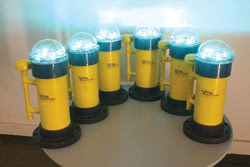
Developed by the Lighting Research Center, these prototype airfield lighting fixtures were used in flight tests in Alaska and North Dakota to validate laboratory results. Positioned at the corners of the runway, they helped to confirm the optimum spectrum, intensity, flash rate and distribution of airfield lighting. Courtesy of the Lighting Research Center.
Rainey said one issue with current LED lighting products is that, to meet FAA specifications, the lights must emulate the dimming curve of an incandescent lamp. This requires extra electronics in the fixture, which adds to the complexity, cost and energy consumption. Another concern that popped up recently, he said, is the LED’s lack of infrared. Some carriers are equipping their aircrafts with enhanced flight vision systems for low visibility landing and taxiing operations. These systems rely on IR to operate, making LED lights invisible to them.
Another concern is that, compared with tungsten-halogen lamps, LEDs produce very little heat, a characteristic that could lead to ice and snow buildup on lenses in cold climates. However, in recent installations of LED airfield lighting in cold climates – with the LED fixture operating at near-ambient temperature – snow and ice did not adhere to the glass as rapidly, according to the technical paper Power Distribution for the All LED Circuit, which was compiled by Rainey and his associate Seward Ford.
All-LED vs. hybrid system
In part, Rainey and Seward’s report addresses the data collected and the potential energy savings associated with the use of an all-LED 2.8-A circuit compared with an existing hybrid system, where LED lights are installed on a standard 6.6-A incandescent circuit. Data was taken from a prototype LED taxiway edge light 2.8-A circuit at Prescott Airport in Arizona. The paper noted that the all-LED circuit provides a number of specific benefits when both lighting circuit and power distribution systems are properly matched and sized to take advantage of the LED potential. Among the benefits are longer LED lamp lifetimes and reduction in the amount of energy required per fixture to meet FAA visual aids photometric requirements. Also, pilots observed that the LED edge lights provided a crisper, brighter and more saturated blue color than existing incandescent lights. Installation of all LED lighting systems is a possible alternative for small airfields with no existing lighting.
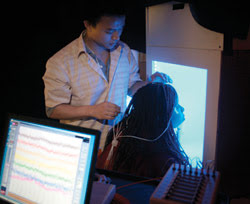
An investigator at the Lighting Research Center adjusts EEG electrodes on a study subject undergoing exposure to blue light. LED technology is being used to create ambient lighting for passenger comfort in aircraft. Courtesy of the Lighting Research Center.
The report also discusses upgrading existing airport lighting infrastructure, alternative power distribution options and the possibility of using solar-powered LED visual aids in airfields.
Aircraft lighting
“LEDs are a very efficient light source [for aircraft] and can significantly reduce seat-mile costs and schedule upsets because of their dramatically increased reliability over filament lights,” said Andre Hessling, manager of advanced product development at Goodrich Corp. in Charlotte, N.C. He said the company designs and supplies LED lighting for aircraft and that, for almost every light used on an aircraft, a LED solution is available – or soon will be.
“Goodrich strongly believes in research – not only for LEDs, but also for the associated and complementary technologies, such as optics, cooling, electronics and state-of-the-art mechanical design,” Hessling said. “Only if the mix is right on the entire package [do] you have a condition in the long run where the customer comes back – and not the product!” In recent years, the company has manufactured innovative products for aircraft such as LED reading lights and bus-controlled LED cockpit lighting, he added.
He noted that luminosity, or the ability to project a narrow, extremely powerful beam, such as for a landing light, is a challenge for LED technology and that Goodrich’s high-intensity discharge lamps are still superior for this application. Temperature also is an issue – heat builds up in powerful LED clusters for headlamps, and LEDs are sensitive to that in terms of degradation and malfunction. And, finally, obsolescence is a problem – the design must accommodate the rapid generation cycles of solid-state lighting.
Jeff Johnston, vice president of platform components for Honeywell Aerospace in Phoenix, said that Honeywell provides LED lighting products for many aviation applications, most notably for exterior aircraft lighting. He noted that LED lighting on the wing tips of an Airbus A320 aircraft can save airline operators up to $30,000 per aircraft over traditional lighting solutions. The longer life of the LED, plus the ease of installation, keeps the aircraft out of the maintenance shop, he added.
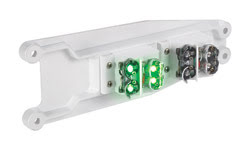
This LED wing-tip light is for an Airbus A2320 aircraft. Courtesy of Honeywell Aerospace.
Honeywell also uses LED lighting on cockpit displays, such as in avionics general aviation and high-resolution flight decks for commercial air transport.
Fade factor
As for challenges to be overcome in LED lighting technology on aircraft, Johnston said that LED light characteristically fades as it ages, to such a degree that it no longer meets the legal requirements of aircraft standards. He said Honeywell’s LED lighting, however, allows operators to predict and schedule maintenance in advance of the fading. The light is engineered to turn off before its required intensity is lost. Space and heat issues also must be addressed because many diodes are required to create the intensity required for aviation, he added. Thermal management is critical to reaping the rewards of higher reliability and lower maintenance costs, he said.
Among its current projects, Honeywell is developing high-intensity, high-power applications such as landing lights.
Navaid Lighting’s Rainey said that, with regard to the characteristic “aging” of LEDs, which leads to lower light output, the use of mobile photometric measurement equipment to target underperforming fixtures will be required to combat the effects of the fading and to keep runway and taxiway lighting operating within FAA- and International Civil Aviation Organization-specified photometric limits.
Standards
Jean Paul Freyssinier, a lighting design specialist at Rensselaer Polytechnic Institute’s Light Research Center in Troy, N.Y., said that an important part of the center’s work is to provide the information necessary so that energy-efficient lighting technologies, particularly LEDs, can be used in airport and aviation lighting. In the case of airport lighting, he added, the technology has been, for the most part, incandescent lamps.
He said the center’s work aims to help rewrite the FAA’s advisory circulars with information, test methods or metrics that would enable the use of LEDs. LEDs face difficulties in being adopted because they do not meet certain standards that were written for a particular technology. In fact, however, he said that LEDs can provide the same or better performance.
Many of the projects the center is working on are related to metrics and testing procedures applicable to aviation and airport lighting. It also is providing support in terms of the changes needed to the electrical infrastructure so that LEDs can be used effectively, Freyssinier said.
The Light Research Center was selected by the FAA to join its Centers of Excellence program. Specifically, the center applies its expertise in the area of solid-state lighting and vision science to provide new lighting solutions that benefit the aviation industry, he said.
Besides aircraft cabin general lighting, for which LEDs have enabled a number of new effects and possibilities, the center’s research in other areas, including light and health, could have a positive effect on long flights, Freyssinier noted. Light can have a positive impact on the alertness of passengers or could alleviate jet lag if applied at the right time.
Boeing chooses LEDs
Reflecting a trend in the installation of ambient lighting in aircraft interiors, B/E Aerospace Inc. of Wellington, Fla., announced in April that The Boeing Co. has selected it to supply cabin lighting for its next-generation Boeing 737 program. B/E Aerospace’s digital LED lighting systems will create a “sky interior,” with adjustable lighting and full-spectrum color capabilities that can provide cabin ambience, or mood lighting, for passenger comfort. The company’s RGB + W Mood Lighting System makes use of LED technology and digital controls to dynamically shift light through a 16.7 million color palette to create a wash of light that modifies the look and feel of a cabin – even to create the effects of sunrise and sunset.